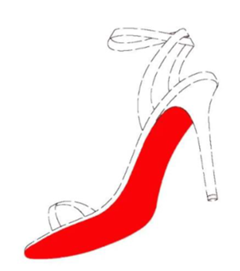1. Regarding whether or not a trademark consisting solely of a single color corresponds to Article 3 Paragraph 2 of the Trademark Act
The intent of Article 3 Paragraph 2 of the Trademark Act is to exceptionally allow a specific person to use even a trademark under the Article 3 Paragraph 1 Item 3 of the said Act whose exclusive use is inappropriate in the public interest as it indicates the characteristics of goods or services in a necessary and appropriate manner in transactions, but which has been used by a specific person in business for many years and thus has come to have a source indication function. In light of the above, in order for a trademark consisting only of a single color, which is particularly required to serve the public interest, to fall under Article 3 Paragraph 2 of the Act it should be understood that the trademark must have acquired a high degree of distinctiveness (adaptability for exclusive use) to the extent that it is recognized as an exception to such public interest.
2. Regarding whether or not the trademark in question corresponds to Article 3 Paragraph 2 of the Trademark Act
The composition of the trademark is not unique, the origin of the plaintiff’s women’s high-heeled shoes can be recognized by the plaintiff’s logo on the insoles, several businesses other than the plaintiff were selling women’s high-heeled shoes whose soles were colored red, which were a similar color to the color of the trademark, and the degree of recognition of the trademark by consumers was limited, as inferred from the results of a questionnaire survey. Taking the above into consideration, it cannot be found that the trademark has acquired a high degree of distinctiveness of the goods of the applicant (adaptability for exclusive use) to the extent that it can be recognized as an exception to the above public interest.

1. Regarding whether or not a trademark consisting solely of a single color corresponds to Article 3 Paragraph 2 of the Trademark Act
Summary 1 of the judgement emphasized the public interest requirement (adaptability for exclusive use) of avoiding unjustified restrictions on the free choice and use of colors for other businesses and required the acquisition of a high degree of distinctiveness in order to fall under Article 3 Paragraph 2 of the Trademark Act, in line with previous court cases (Intellectual Property High Court Case June 23, 2020 (Case No. 2019 (Gyo-ke) 10147) (Presiding Judge Takabe) [Hydraulic excavator component part single color trademark case], Intellectual Property High Court Case August 19, 2020 (Case No. 2019 (Gyo-ke) 10146) (Presiding Judge Ootaka) [Hydraulic excavator single color trademark case], Intellectual Property High Court Case January 24, 2023 (Case No. 2022 (Gyo-ke) 10062) (Presiding Judge Honda) [Pencil Single Color Trademark Case], etc.).
2. Regarding whether or not the trademark in question corresponds to Article 3 Paragraph 2 of the Trademark Act
Assuming Summary 1, with respect to a trademark consisting of solely of the color red (PANTONE 18-1663TP) applied to the soles of women’s high-heeled shoes, Summary 2 of the judgement denied the acquisition of high degree of distinctiveness and denied registration under Article 3 Paragraph 2 of the Trademark Act. While the followings are examples of registration of trademarks consisting only of colors, all of which are combinations of multiple colors, a trademark consisting solely of a single color (without outline) has been denied registration under Article 3 Paragraph 2 of the Trademark Act in some court cases, as shown below, as with Summary 2 of the judgement, thus the hurdle for registration is considered to be quite high.
| Owner |
Reg. No. |
Registered Trademarks |
| Tombow Pencil Co., Ltd. | No. 5930334 |
|
| SEVEN-ELEVEN JAPAN CO.,LTD. | No. 5933289 |
|
| Sumitomo Mitsui Financial Group,Inc. | No. 6021307 |
|
| No. 6021308 |
|
|
| Mitsubishi Pencil Co., Ltd. | No. 6078470 |
|
| No. 6078471 |
|
|
| Family Mart Co.,Ltd. | No. 6085064 |
|
| UCC UESHIMA COFFEE CO., LTD. | No. 6201646 |
|
| NISSIN FOODS HOLDINGS CO., LTD. | No. 6534071 |
|
|
Applicant |
Applied Trademarks |
Court Cases denying registration |
|
LIFULL Co., Ltd. |
Consists solely of orange (Combination of RGB:R23, R237, G97, B3) |
Intellectual Property High Court Case March 11, 2020 (Case No. 2019 (Gyo-ke) 10119) (Presiding Judge Ootaka)
|
|
Hitachi Construction Machinery Co., Ltd. |
Consists solely of orange (Munsell color system:0.5YR5.6/11.2) |
Intellectual Property High Court Case June 23, 2020 (Case No. 2019 (Gyo-ke) 10147) (Presiding Judge Takabe)
|
|
Hitachi Construction Machinery Co., Ltd. |
Booms, arms, buckets, cylinder tubes, building covers and counterweights of hydraulic excavators to be orange (Munsell color system : 0.5YR5.6/11.2) |
Intellectual Property High Court Case August 19, 2020 (Case No. 2019 (Gyo-ke) 10146) (Presiding Judge Ootaka) |
|
Mitsubishi Pencil Co., Ltd. |
Consists solely of “DIC Color Guide PART 2 (4th Edition) 2251” |
Intellectual Property High Court Case January 24, 2023 (Case No. 2022 (Gyo-ke) 10062) (Presiding Judge Honda)
|
【Keywords】Article 3 Paragraph 2 of the Trademark Act, Acquisition of distinctiveness thorough use of a trademark, New type of trademarks, Trademarks consisting only of colors, Trademarks consisting of only of single colors, Free choice and use of colors, Public interest, Adaptability for exclusive use, Christian Louboutin
※ The contents of this article are intended to convey general information only and not to provide any legal advice.
Kei IIDA (Writer)
Attorney at Law & Patent Attorney (Daini Tokyo Bar Association)
Contact information for inquiries: k_iida☆nakapat.gr.jp (Please replace ☆ with @.)